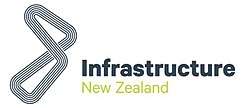Infrastructure New Zealand
Infrastructure New Zealand (formerly New Zealand Council for Infrastructure Development) is an industry association that promotes national infrastructure development through research, advocacy and public and private sector collaboration. The members come from diverse sectors across New Zealand including equity owners, service providers, public sector agencies, and major infrastructure users.
Infrastructure New Zealand Incorporated | |
 | |
| Predecessor | New Zealand Council for Infrastructure Development |
|---|---|
| Formation | August 3, 2004 |
| Type | Non-governmental organisation |
| Location |
|
Chief Exective | Paul Blair[1] |
Key people | Andrew Stevens, Chair |
| Website | infrastructure |
History
The organisation was originally formed as the New Zealand Council for Infrastructure Development, and was first incorporated in August 2004. It was renamed as Infrastructure New Zealand in April 2017.[2][3]
Criticisms of the Resource Management Act
During a visit to Whangarei in February 2020, the Chief Executive of Infrastructure New Zealand, Paul Blair, called for major changes to the Resource Management Act 1991. Blair advocated for the Act to be replaced by a sustainable development act that would refer to a set of national environmental standards. Development would be able to proceed where it could meet those standards. He criticized the way that the present Act allows the views of a local community to over-ride the best interest of a wider region, and urged that social, cultural and economic perspectives must be considered in regional development decision making, not just environmental impacts.[4]
As part of planning for economic recovery following the COVID-19 pandemic, the Minister for the Environment announced on 3 May 2020 that the Government would amend the law to allow fast-tracking of selected projects through the RMA. [5] The announcement was welcomed by Infrastructure New Zealand. In a statement on 4 May, the Chief Executive said that “the RMA has become a litigious, cumbersome, and complex piece of legislation. It was never intended to be applied the way it has been, and it was not designed to facilitate recovery from something like the COVID-19 lockdown”.[6]
Response to COVID-19 impact
In response to the COVID-19 lockdown ordered by Government on 25 March 2020, the Chief Executive of Infrastructure New Zealand, Paul Blair noted that the construction sector was already in a precarious situation prior to the pandemic, and that one third of all construction jobs were at risk within months. He urged the Government to create sector-specific criteria that would allow the construction industry to return to work immediately, with appropriate health and safety measures in place.[7]
After the Government announced an intention to stimulate the economy with investment in “shovel-ready” projects, competing views were expressed about the most appropriate sector to take this investment. Paul Blair said that the Government’s COVID-19 response provided a "once-in-a-generation chance to transform New Zealand" through infrastructure.[8]
Annual symposium
Infrastructure New Zealand hosts an annual conference "Building Nations". The theme of the 2019 conference was "Building Regions – how we can position our regions for growth, fund the investment we need and tackle the challenges facing our water, housing and transport sectors". Topics covered in the conference were:[9]
- Housing and Urban Development Authorities
- Connecting Regions
- Water Sector Reform
- Construction Industry Accord
- Lifting the Capability of the Infrastructure Sector
- Local Government Funding
- Better Procurement Models
Publications
- Evaluating the environmental outcomes of the RMA - A report by the Environmental Defence Society - June 2016
- Building National Infrastructure Capability: Lessons from Scotland - June 2017
- Benefits from Auckland road decongestion – July 2017
- Meeting Auckland’s Growth Challenge: The Innovation City - Discussion Document – October 2017
- Gender Diversity for Engineering Professional Services - Workshop Summary Report – December 2017
- Enabling City Growth – Lessons from the USA – June 2018
- Creating Value through Procurement – A report into public sector procurement of major infrastructure projects – August 2018
- National Development – Insights from Asia – June 2019
- Building Regions – A vision for local government planning law and funding reform – August 2019
See also
References
- "Infrastructure New Zealand announces new CEO". Scoop. 15 July 2019. Retrieved 8 May 2020.
- "Incorporated Societies Register". Retrieved 8 May 2020.
Incorporation number 1542207
- "Infrastructure New Zealand History Timeline" (PDF). Infrastructure New Zealand. Retrieved 1 May 2020.
- Botting, Susan (5 February 2020). "Infrastructure NZ says RMA needs to be replaced". RNZ. Archived from the original on 11 May 2020. Retrieved 11 May 2020.
- "Covid 19 Coronavirus: Fast-track consent for 'shovel-ready' projects". NZ Herald. 3 May 2020. Archived from the original on 4 May 2020. Retrieved 5 May 2020.
- "RMA: 'We would love to see this fast-track become the new-normal'". RNZ. 5 May 2020. Archived from the original on 11 May 2020. Retrieved 12 May 2020.
- Flaws, Bonnie (31 March 2020). "Construction sector calls for its own coronavirus alert levels to keep sector afloat". Stuff. Archived from the original on 10 May 2020. Retrieved 11 May 2020.
- Harris, Catherine (29 April 2020). "Infrastructure and home building sectors vye for shovel ready cash". Stuff. Archived from the original on 10 May 2020. Retrieved 11 May 2020.
- "Building Nations Symposium 19". Infrastructure New Zealand. Retrieved 1 May 2020.